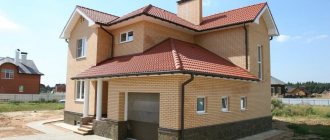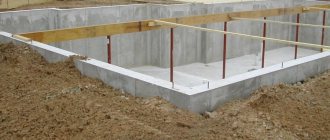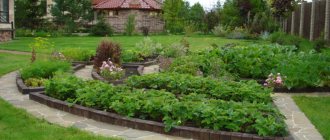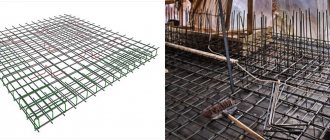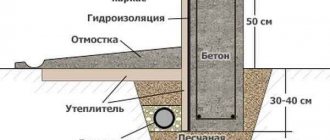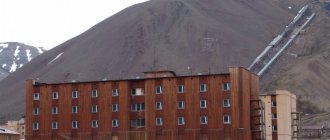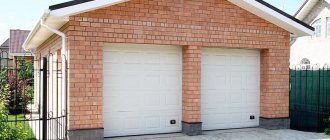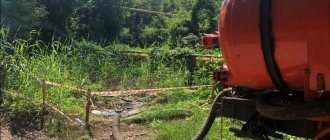Laying a foundation on an area with an uneven surface is associated with certain difficulties. First of all, for the correct calculation and design of the foundation of a house, a geodetic survey of the construction site will be required, which will reveal the degree of slope of the site, and geotechnical surveys, which will determine the composition of the soil being developed. There is no point in saving on such work, although it does lead to considerable additional financial costs.
Foundation on a slope: subtypes of strip foundations and installation.
In mountainous areas, as well as on hilly plains, when building a house, it is often necessary to lay a columnar or strip foundation on a slope. For stone and concrete residential buildings, the second option is most often used, which, in turn, is divided into subtypes. Below we will learn how such a base is made, and also, as additional material, watch the video in this article.
How to make a strip foundation on a slope.
Strip foundation of a house on a slope
Required tools and materials
Regardless of what type of strip foundation you plan to build yourself, whether shallow or stepped, the list of necessary materials and tools is not much different. So, you will need:
- shovel;
- wooden pegs;
- sand, you can use wet;
- cement;
- gravel;
- roulette;
- reinforcing bars;
- welding machine;
- Master OK;
- material for arranging a waterproofing layer;
- building level.
Foundations and their arrangement.
How to make a foundation on a slope.
House on a pile foundation on a slope.
For the construction of residential and industrial buildings, four main types of foundations are used: pile, strip, slab and columnar.
But for slopes it is much more convenient to use the last three options. The fact is that when laying a slab foundation on a slope, you need to make a flat area and for this you will have to either pour soil or dig it out, which is very troublesome and expensive.
We will draw your attention to the various devices of strip foundations, which are suitable for the construction of any light or heavy structures.
Subtypes of strip foundations.
Subtypes of strip foundations.
- All strip foundations on slopes and plains can be divided into monolithic (made of reinforced concrete) and prefabricated (made of various blocks, bricks or stones). The first device is the most popular as it is the most durable and does not require long installation times, while brick or stone masonry is a rather labor-intensive process.
In addition, masonry will not be able to last as long as reinforced concrete, because there is a statement that the process of hardening of cement mortar occurs within 49 years, and for the next 49 years the concrete returns to its original state.
- In addition, strip foundations can be buried or shallow, but this parameter is determined by the instructions, which correspond to the lowest freezing point of the soil. If a trench is dug above this point, it is considered shallow, and below this point, it is considered deep.
- But the shallow option is suitable only for stable, non-heaving soils, and for heaving and man-made soils, deepening is used for any weight of the building.
- The general structure of the foundation on a slope remains virtually unchanged, with the exception of its upper part, which will protrude to a greater extent above the ground.
In any case, the bottom of the trench must be strictly horizontal and a sand or concrete cushion is placed on it. For the upper part, you install the formwork yourself in exactly the same way, only on the slope it will turn out to be higher.
Calculation of right angle.
Advice. If you do not have a theodolite, then the right angle for marking the perimeter can be calculated using a regular tape measure. To do this, hammer a wooden or metal peg in the right place and tie two threads to it - one for 3 and the other for 4 meters. If you spread their ends exactly 5m apart, the resulting angle will be exactly 90⁰.
Trench for filling.
- Now we will learn how to fill the base on a slope. And first of all, you need to mark the outer perimeter and all partitions that require a base of this type.
The width of the trench must be no less than the thickness of the wall that will be located on it, and if the foundation turns out to be wider than the wall, this will not in any way reduce the structural qualities of the building. If the slope in the area is small, then the bottom of the trench can be made at the same level, but in no case under a slope, because this will create conditions for displacement.
You cannot build a foundation near a pit.
Stepped foundation on a slope.
- It happens that it becomes necessary to build a house on a strong slope, and then it may turn out that the bottom of the trench at the beginning will be more than a meter deeper, and this means additional costs plus an increase in labor intensity. Therefore, in such cases, the foundation is made in steps, but always with a strictly horizontal base, so that there are no preconditions for shifting.
Reinforcement of strip foundation.
- For prefabricated foundations, stepped arrangement does not present any particular difficulty, but for a monolithic concrete structure, reinforcement is required. The difficulty here is that the frame must be solid, and the steps will prevent this. Therefore, it is better to knit it not separately, but in a trench.
- The lower bearings will be laid separately on each step, and the vertical lintels should rise almost to the top level of the foundation. Therefore, it will be necessary to add two more levels of carriers - in the middle and at the top, thus obtaining a rigid structure.
Advice. When pouring the frame with concrete, the distance of the reinforcement to the outer wall must be at least 5 cm, so as not to create conditions for corrosion and rust. The sand cushion (sole) should be watered generously so that the sand settles and does not sag during use. It is much more difficult to achieve such a result using tamping.
As you understand, building a foundation on a slope is somewhat more difficult than on a flat plane and this requires additional work. Also, on strong slopes, it is recommended not only to have a stepped foundation, but also to build the house itself in cascades (also find out how to make a non-buried strip foundation).
We choose the foundation in accordance with the characteristics of the house
A classic shallow foundation of a strip type on a slope can be constructed at a slight slope angle. If this requirement is met, then such a basis is permitted for use.
Diagram of a strip-type step foundation on a slope
For steeper slopes, a strip stepped foundation would be the best option. The peculiarity of this design is that it is built in the form of steps, the number of which increases as you approach the top of the slope. Such a foundation will be strong enough and able to withstand heavy loads coming from the slope.
We also note that on slopes where large soil movements are observed, it is better not to arrange a strip foundation at all, giving preference to foundations of a different type. In general, strip foundations are recommended to be installed on slopes only in cases where the slope is located at a slight angle. Setting up a shallow foundation for a strip-type house should be done after obtaining the appropriate permission from geodetic services.
The construction of a strip foundation on a slope always begins with preparatory work. The craftsman will need to study the place where the foundation of the house is being built, then thoroughly clean it of debris and, of course, directly mark the place where the foundation will be poured. This work is carried out using auxiliary tools - a tape measure and a strong cord.
When arranging a foundation on a slope, construction experts advise taking into account the following characteristics of the selected area:
- Slope angle. This parameter is considered the main one among all the others, because the choice of the type of base will depend on it.
- Groundwater level. Based on this indicator, the depth to which the base should be lowered is subsequently determined, and a choice is made in favor of one or another type of waterproofing.
- Soil composition. In accordance with this parameter, the depth at which the foundation will be laid is selected, and the drainage system is equipped.
Advice. Pay special attention to the design of the drainage system and the formation of drainage. It is the moisture coming from above that often washes away the foundations of a residential building, significantly reducing its service life.
Due to moisture, the stability of the building is weakened, and building materials lose their functionality. In addition, water can change the topography of slopes, gradually washing away soil from them. Soil collapse should be prevented in advance, before the foundation is laid. To this end, several effective measures are being taken:
- Creation of plantings consisting of shrubs and trees with a developed root system. This method is one of the most inexpensive and effective, allowing you to strengthen the soil on slopes of any steepness. In addition to this function, trees will also decorate the natural landscape located around the building.
- Mechanical systems that strengthen soil. They are mainly represented by metal spacers dug throughout the entire surface of the slope.
Scheme for safely preparing a site on a slope for foundation construction
Before starting to build a foundation on a slope, you need to make sure that the soil has good bearing capacity and the slope is sufficiently stable. In construction, it is believed that the safest degree of slope on sandy soils is considered to be 27 - 31ºC. If construction is carried out on clay soils of a hard-plastic nature, or on soils of glacial origin, the slope angle can reach 70 ºC.
Construction of a foundation on a site with a slope.
Columnar strip foundation made on a slope.
Ideally level sites for building houses are quite rare; a new plot allocated for development may be marked by holes, slopes, and elevation changes.
But if relatively minor errors can be leveled out and filled in with a little work and expense, then on a site with a large slope, building a house requires more serious efforts.
A comment
- Registration: Mar 2011
- Posts: 26
Answer: Insulated, undamaged slab on a slope.
Let's continue the epic. On the top half-meter layer ( crushed stone-gravel was removed
to the side) the density meter gave:
The testing laboratory (SOYUZDORNII certificate) carried out work to determine the compaction coefficient at the base (cushion) of a slab foundation. Tests were carried out in accordance with GOST 19912, 22733-2002 using a static density meter at 5 points.
1st point (high part of the embankment) - instrument readings 50, 35, 42, 32,32 2nd point (also high part) - 10,33,29, 30, 25 3rd point (middle) - 40,39,32,40, 48 4th point (middle) - 38,38,32,31,28 5th point (low part) - 25,30,39,29,36 which corresponds to the compaction coefficient - 0.95 -0.96
I understand correctly that the snip has the same number.
The people are a mercantile-monetary issue. If this compaction coefficient plus 15 cm of crushed stone is sufficient
for the construction of a ribbed slab on foam plastic with a load of 120-150 tons from the house (porous ceramics - one floor - 44 cm) I will want money for the work performed. If everything is bad—(who knows—poke into the calculation)—you’ll have to tear everything down. Yahoo. Yahoo. Yahoo!: Done—one to one, as in the picture
Features of laying a foundation on a slope.
The first significant difficulties arise at the stage of laying the foundation. A pedestal for a strong and reliable house must also be solid, not collapse under the influence of groundwater and not be subject to soil shedding. These problems significantly complicate the strengthening of the subwall on slopes.
However, if you correctly calculate your material capabilities, technical characteristics, type of soil and choose the right type of foundation, then a house beautifully built on a hillside will delight the owners with its advantages: beautiful landscapes from the windows; the ability to equip a house, a garage, and a bathhouse in one room; wonderful natural landscape.
To strengthen a building on a slope, the following types of foundation are most often used:
- tape stepped;
- pile;
- columnar.
The design of any of these types of pedestals has a number of advantages and disadvantages, so there can be no clear advice on which one to choose. It all depends on the specific location and the capabilities of the owner of the territory.
A slab foundation is not used on a site with a slope, as it requires a very large scale of excavation and strengthening work to level the site.
In this video you can watch step-by-step instructions for building a foundation on a slope.
Building a house on the relief
By terrain we mean the structure of the surface - mountains, lowlands, hills, valleys, ravines, bulges and depressions, plateaus. The relief is determined by the slope - the fall of the surface, which is calculated by the ratio of the difference in height between two points on the ground to the distance between these points projected onto the horizontal (see figure) or the tangent of the angle of inclination of the terrain line to the horizontal plane at a given point. Slope is measured as a percentage. For example, a rise of 15 m per 100 m of horizontal movement corresponds to a slope of 0.15 (15%).
Relief slope diagram
Flat terrain is considered if its slope is no more than 3%, a low slope is from 3 to 8%, an average slope is up to 20%, and a steep surface has a slope of more than 20%. The best from the point of view of construction are areas that are flat or with a minimal (up to 3%) slope towards the south, as well as those that have a minimum slope from the central part down on both sides (Fig.)
Schemes of the most successful sites for construction with a minimum slope
Here, construction is made as easy as possible: with such a topography on the site, various options for the location of the house and other buildings can be implemented.
Sites with a slope of up to 3%
can be used in the construction of standard houses. Only small slopes are required to drain water from buildings - they are created by adding soil, when using stones, gravel, cement, a small slope is created from the house to the surface with a height of approximately 50 cm. The width of the fill is on average 1-1.5 m wider than foundation.
If the slope is small - up to 7%,
then it is suitable for the construction of buildings without basements. However, it is possible that at a slope of 5-7%, soil will need to be added from the foothills (see figure).
A site with a slight slope of 5-7% with soil added to the foothills of the slope
If the slope exceeds 8%,
the unevenness of the surface can be used to construct a basement floor. In such cases, they do not make a flat platform, but create a lower floor by cutting out part of the slope mass. This option is good for building an underground garage, if access is possible from the side of the slope (see figure).
A site with a cut-out part of the slope for the construction of an underground part (garage, etc.) with a slope above 8%
When the slope is steep and exceeds 15-20%,
It is worth considering developing a special house design that takes full advantage of the steep slope. The inconveniences of a slope can be turned into undeniable advantages if you use it to build a multi-tiered dwelling, which will make it possible to create separate blocks in the building: for example, guest rooms with their own entrance, a workshop, a summer kitchen, a garage, a storage room. If you have to build on difficult terrain, you need to turn the site into several leveled, flat surfaces. All buildings are placed on horizontal platforms, and their width determines the size of the buildings.
To do this, terraces are created, which are secured with retaining walls and connected by steps. Even with a slope of 12%, buildings are best erected on terraces (see figure).
A site with a steep slope (more than 15%) equipped with terraces with retaining walls
A house built on terraces can be multi-level, have verandas on different tiers, balconies, and patios. The terraces also have platforms, paths, recreation areas, gazebos, and so on.
In the case of a significant difference in relief, more than 15%, it is recommended to install retaining walls so that the vertical seams in adjacent rows of stones do not coincide. Retaining walls are made of concrete slabs, boulders, bricks, timber, stones (see figure).
Terrace made with retaining walls made of boulders with a slope of more than 15%
If the wall height is high, the stones are held together with mortar. The largest stones are located in the bottom row. To increase the strength of the retaining wall, all rows of stones are laid with an inward slope. The slope along the boundaries of the site is also secured with stones, and the best material for this will be granite, sandstone, and limestone.
Strip foundation on a slope.
A strip foundation is the most common type of foundation being erected during the construction of buildings, which is constructed independently. It can also be poured on a slope, but the following nuance must be taken into account: the height of the base at its lowest point should not exceed four times its width. The steeper the slope, the higher the base will be, the wider it should be, and the greater the cost of formwork and concreting.
How to make a foundation on a slope.
Construction of a foundation structure on a site with a slope.
The relative simplicity of constructing this type of subwall can be considered an advantage. With little expense, this type of foundation can be built on a site with a slight slope, for a garage or a foundation for a bathhouse. With a significant steep slope, such a device will be associated with significant difficulties.
- high costs for formwork and pouring: already a meter high foundation for a house will lead to an almost double increase in construction costs;
- a significant amount of excavation work;
- Shallow structures are very difficult to use, and sometimes simply impossible.
These costs are justified if high poured walls are planned to be used to equip a workshop, garage, or bathhouse in the basement. In this case, space and money are saved for the construction of these or other utility rooms.
How to make a foundation on a slope.
Scheme for building a strip foundation on a site with a slope.
Features of the construction of a straight strip foundation on a slope:
- Part of the slope for the top of the subwall is cut off exactly at a right angle and a retaining wall is built, which will be the upper part of the perimeter of the future base.
- The formwork is installed in the usual way. the lower part of which, by the difference in height, is horizontally leveled with the retaining wall.
- Laying reinforcement and pouring concrete is no different from a similar process on level ground.
- About a month is allotted for the foundation to completely harden and shrink, after which a support embankment is built along the slope under the lower wall to level out the difference in heights.
What types are suitable for the slope
It is possible to construct different types of tape.
By design can be selected:
- Monolithic tape.
- Prefabricated foundation.
By depth of immersion:
- Shallow.
- Recessed type.
Experts recommend building monolithic structures, since the load-bearing capacity and resistance to axial tensile loads of prefabricated belts is much lower. Considering the specifics of the placement and the possibility of soil movement under the influence of the weight of the building, the choice is completely justified and obvious.
There is also a general consensus regarding the depth of the tape. It is recommended to prefer the recessed type, since heaving loads in winter are directed at an angle and are capable of moving the base down the slope.
The greater the angle of inclination, the greater the immersion depth should be.
Stepped foundation on a slope.
For buildings on slopes with a significant degree, it is easier and more economical to use a stepped strip foundation. A stepped foundation, unlike a straight one, does not have an even perimeter, but is arranged in ledges in some variations:
- The upper part is straight, the steps are in the lower part, at the base of the hill;
- The upper part and, accordingly, the walls are mounted in a stepped manner, and the lower part is poured as a simple strip foundation;
- The steps are located along the entire length; the walls of the house will also be stepped.
If the first method is the simplest option and is possible for self-filling, then the second and third have a complex formwork structure and require certain engineering knowledge and skills.
How to make a foundation on a slope.
The complexity of a strip stepped foundation is aggravated by the fact that the reinforcement for pouring also needs to be laid in steps, but the cost of formwork and pouring is significantly reduced, and there is much less excavation work compared to direct work. The construction of this type of foundation for a house can be combined with general terracing and landscaping on the site.
It is also possible to place outbuildings in the basement with this type of construction, but only in the lower sectors. The upper part of the house is used more for living quarters.
Sequence of construction work
Independent construction of a strip-type foundation on a slope is carried out using a special technology, which involves stage-by-stage execution of work.
- Preparatory work. Before laying a strip foundation, it is necessary to carry out so-called exploration work, which involves the formation of small-diameter wells. Their main purpose, of course, is to provide information about the depth of groundwater. In addition, they will become a source of clean spring water.
- Calculation works. They are performed in order to determine the weight of the foundation, its pressure on the soil, the expected weight of snow and wind loads, and the dimensions of the foundation. Next you will need to correct the received data. The weight of the house can be obtained from the volume of the building, which, in turn, is calculated mathematically. Having determined the amount of building materials, the specific gravity can be calculated. Having the exact volume of the house and the specific gravity of the materials, you can easily calculate the total weight of the entire foundation. To this value you need to add the weight of all household appliances that will be located inside the house, as well as the weight of the car (if there is a garage inside the residential building). The depth of the foundation is determined in accordance with calculations of the soil in the area allocated for construction. If the main material in the soil is sand, then the depth of the trench should be at least 0.7 m; in clay soils, the depth of the base should be greater than the freezing depth, and in non-heaving soils – approximately 0.5 m.
- Construction of a trench. The depth of the foundation will depend on the type of soil prevailing in the area chosen for development. In dry soils, the depth of penetration may be slightly greater. In this case, the minimum depth parameter is still 50 cm. The width of the dug trench should be slightly larger than the width of the house wall. The bottom of the pit should be made level; no slopes are welcome. If the slope is too strong, then builders recommend constructing a stepped strip foundation on such a hill. But in this case, according to the instructions, the sole of the base must be strictly horizontal. If you plan to make the foundation structure monolithic, then you should definitely make reinforcement that will prevent premature destruction of the foundation.
Digging a trench for installing a strip foundation with a slope - Forming a sand cushion. This element of the foundation structure is mandatory, because with its help the load on the ground is distributed evenly. The thickness of the pillow, as usual, is 10-15 cm, and after laying the sand needs to be leveled, moistened and compacted well. If the base of the building turns out to be slightly larger than expected (namely, 40 cm), then an additional gravel or crushed stone embankment is laid on top of the sand layer. The thickness of the layer of this embankment should be the same as the sand embankment.
- After the formation of the sand embankment, the formwork is installed, then reinforcing elements are placed in it, and after that concrete is poured into it. To prepare the solution, it is best to take M200 grade cement. The process of pouring mortar into the formwork must be continuous, otherwise the strip will remain vulnerable in the places where the boundary of the pours of the strip foundation being formed is located. The poured solution should be immediately compacted using a deep vibrator. The poured concrete must be allowed to harden well (usually this takes about 1 month). Only after this period can construction of the building begin.
- Waterproofing the base. A foundation on a concrete slope requires high-quality waterproofing. For this purpose, a rolled or built-up material is laid on top of the hardened concrete to prevent moisture from affecting the base. The need for a drainage system should not be ignored. The concrete foundation will undoubtedly prevent groundwater from moving down from the hill. However, moisture will gradually destroy the foundation and shorten its service life. The presence of a drainage system will prevent erosion of the foundation of the house. It should be noted that when installing drainage, it is necessary to take into account the steepness of the slope and the bedding of the soil. For greater reliability, it is better to install drainage around the entire house.
So, if a shallow foundation of a strip or stepped type is made in accordance with all building codes, then a dwelling located on a slope will stand for a long time precisely thanks to high-quality support.
Pile foundation.
If placing a bathhouse and other utility rooms under the same roof as the house is not essential, you should pay attention to a pile foundation. This variety is the most successful option for sloping areas.
- Labor-intensive and costly excavation work is reduced to a minimum.
Preparing to pour the foundation on a slope.
Excavation work in preparation for pouring the foundation on a slope.
- The threat of building destruction when the top layers of soil crumble is prevented - the piles reach the deep layers of the soil.
- The construction will also not be threatened by stormwater and groundwater - a problem for all areas on slopes.
- In areas with heavy soil types and high soil freezing, a pile foundation remains the only correct solution for the construction of reliable and durable structures.
- Pile foundations can be used for any type of building - from light country wooden houses to heavy and tall structures.
Pile structures differ in various parameters: by the method of immersion, by bearing loads, by the shape of the section, by the type of base.
Depending on the need for strengthening, pile foundations come in several types:
- The pile foundation around the perimeter of the house, combined with a strip foundation, is an extended structure along the entire length of the perimeter.
House on a pile foundation on a slope.
Diagram of the installation of a pile foundation on a site with a slope.
- Single piles are used to support individual elements, such as columns.
- Pile bush - piles are concentrated to strengthen one, most difficult area. For example, a house fits into a slope at three corners, and the fourth needs to be supported by a support.
- On a site with a slope, the most common use is a pile field, when the structures are located under the entire area of the future building.
A necessary element for constructing a foundation using piles is a grillage. These are structures that connect piles. They can be monolithic or prefabricated.
Depending on the type of soil and the required degree of strengthening, piles can be laid in one of several ways:
- Driving reinforced concrete, metal or wooden structures into the ground. Excavation work is excluded here altogether;
House on a pile foundation on a slope.
Construction of a pile foundation on a slope.
- Pouring concrete mixtures and installing reinforced concrete pillars requires minor work in the ground, which consists of preparing trenches;
- Screwing in screw piles using special equipment. Excavation of the earth layer is also not required.
Construction of the foundation for a house on stilts comes down to the following steps:
- The first elements of the pile foundation are screwed in, driven or poured at the highest point of the future foundation. The depth from the entry into the ground will be the greatest, and the above-ground part will be equal to the smallest height of the base.
- The part that will be the highest is mounted next. A rope is pulled between the low and high edges, and using a level they are aligned strictly along horizontal lines.
- Subsequent piles are driven in the required places between the corner ones, aligned to the required horizontal level.
House on a pile foundation on a slope.
Ready-made project of a two-story house made of timber on a pile foundation.
- The last stage is pouring a monolithic grillage or mounting its prefabricated structure.
Calculation work
Carrying out calculation work based on data obtained as a result of research can be carried out independently, using information from textbooks on GOST construction, etc. To facilitate the task associated with such calculations, specialized computer programs or a regular online calculator, which is available on some construction sites, will help.
Sometimes, due to weak or overly mobile soils on slopes, it is necessary to create a combined strip-pile foundation. And in this case, information about the maximum level of load on the pile structural elements is of great importance. The master will also need to determine the step at which the piles should be mounted. To do this, you will have to calculate the load on the grillage, as well as the total weight of the structure. In addition to these characteristics, you must have information about:
- The weight of the screed.
- Weight of floors.
- Weight of flooring.
- The materials used to form the roof and partitions, as well as their weight.
- Level of wind and snow loads.
- Weight of rafter structures.
- Degrees of payloads.
The concept of calculation work also includes determining the costs of building materials that the master will definitely need. These expenses can be determined based on the expected material expenses, depending on the following factors:
- The amount of materials required for the construction of the foundation (pile elements, crushed stone, sand, concrete).
- The cost of renting special equipment.
- Price for geodetic surveys and land works.
- Payment for soil testing services at the construction site.
- Costs for the installation of reinforcing systems for soil and drainage structures.
In general, building a house on a mountain or hilly slope is considered unacceptable, but in some cases it has certain advantages. In particular, residential buildings located on hills are reliably protected from flooding during heavy rainfall. Another advantage of building on hills is the resistance of buildings to strong winds. Well, in order for the house to be as strong as possible, it should be built either on a strip, or on a pile, or on a stepped foundation. All of them are characterized by reliability and practicality.
Columnar foundation.
A columnar foundation consists of supports made of pillars, arranged in special pits, deepened to stable soil. The upper and lower parts of the base are a kind of supporting wall. The construction of such a subwall is advisable for buildings on ready-made terraces or on an area between two slopes.
Column and pile foundations are distinguished by the fact that columns poured into recesses can withstand significantly lower loads than driven piles. After leveling and strengthening the site using a columnar foundation, further installation is similar to work on a flat surface.
Choosing a base for stone surfaces
When constructing a building on rocky terrain, you can use the following foundation:
- A deeper strip foundation is used mainly in cases where the site is not solid rock and it is possible to lay the structure to a depth of at least 70 cm. When installing the foundation, a number of works will be required . First of all, you will need to remove the soil to a certain depth and make a pit for the foundation. The platform is also leveled and secured. At the end of the pit a sand cushion is laid. Its thickness should be about 30 cm, and waterproofing is provided above it. When the base is prepared, formwork is carried out, a reinforced belt is laid and concrete is poured.
- A shallow tape base is laid out to a depth of 30cm. Since the depth is shallow, you can do without a sand cushion. If the ground is flat, you can forget about the reinforced belt. This will save you money on a basic device.
- There are examples of using slab foundations, but taking into account all the features, building this type of foundation on rocky soil is an extremely expensive undertaking. As a result, more budget options win.
- The optimal solution for rocky soil would be a columnar foundation. The structure consists of supports with a mesh. The supports are slightly recessed, which gives stability to the foundation. The advantage of such a foundation is the speed of construction and low costs.
Features of building a foundation on a rock
The construction of the foundation begins with the removal of soft soil and marking of the area. According to the developed scheme, square-section pits are constructed. In the future, they will be equipped with supports made of concrete blocks, wood or brick. The disadvantage of wooden supports is their fragility: the average service life is 9 years. As for masonry, it will slightly extend the construction period.
Rocky soil has the following characteristics:
- does not freeze;
- does not shrink;
- not subject to frost heaving;
- withstands significant loads.
This type of rock is universal for different types of foundations. However, it is still better to refuse to install a pile structure.
The design of a foundation on rocky ground can be very simple. For example, a base in the form of a shallow tape. Any type of support can support a large weight of the structure, since the rock itself becomes the foundation. The best option is a columnar foundation on a rock when buried to a shallow depth. The pillars are installed in drilled wells. To increase the strength of the structure, an expansion is made at the end of the support. When erected on solid rock, there is no need to deepen the foundation, since good load-bearing capacity is provided by the rock itself. The structure is connected with a grillage. The base is reliable and stable. Its advantages include low costs and quick construction.
Strengthening the slope under the foundation.
The general requirements for any type of plinth on an area with a slope are reliable ground support. The main threats are: firstly, streams of rain and melt water, which wash away the soil around the house and accumulate in the upper part of the foundation, gradually destroying it; secondly, possible shedding and displacement of the soil.
For the safety of buildings on such a unique site, it is necessary to carry out a number of measures:
Drainage installation around the foundation on a slope.
Drainage installation around the house.
- Retaining slabs, terraces, planting trees and shrubs with a powerful branched root system are not only design techniques, but methods of strengthening the soil and preventing its displacement;
- The soil under the site, on installed piles, is especially susceptible to crumbling. There are no plantings in this place; grass and shrubs do not grow. Such areas are especially protected from rainwater. Melt and groundwater must be drained from under the piles using drainage devices.
Features of rocky soils
Rocky soils are composed of various rocks that have their own distinctive features:
- Granite. This popular material is widely used in the construction and finishing of various buildings. It has very high strength and durability.
- Sandstone. The rock is represented by threshed grains associated with minerals (mainly cement). It has high porosity and is widely used as a wall material.
- Limestone. The rock is made of calcite. Resistant to erosion and deformation.
In addition, heaving forces do not act on the walls of a foundation built on such soil. This prevents the foundation from shifting and the destruction of the structure, which later occurs in this case.
Disadvantages of Rocky Ground
Of course, despite all this, soils also have disadvantages.
Experts identify the following disadvantages of rocky soils::
- During construction, the use of special equipment will be required, which will slightly increase the cost of construction.
- Buildings with a basement cannot be built on such soils.
- Problems may arise with the installation of drainage and the laying of communications.
How to make a foundation on a slope.
Building a house on a slope is always a risky idea, because no one is safe from soil shedding, flooding with water coming from above the slope, or subsidence. That is why the foundation is on a slope, and the house design itself must be drawn up by a real professional. This article was created so that you can understand the types of foundations for a house on a slope. After reviewing the information, you will be able to make the right choice and understand the engineers' project. You can make the design with your own hands, the main thing is to strictly follow the project.
How to make a foundation on a slope.
A good example of a house on a slope is the optimal angle for construction. If the slope is greater, then there is a chance of soil displacement and other unpleasant phenomena for the owners.
Despite the complexity, there are plenty of foundation options for building on a slope. You can choose a strip, column or even pile foundation. Another negative point is the need to spend money on strengthening the soil. Sometimes this operation can be avoided if the building stands on “favorable” soil.
Construction of retaining walls
The house built in the middle of the slope will be located under the overhanging upper part of the slope. In order not to expose the house to the risk of collapse and sliding of the soil from above, it is necessary to erect a retaining wall.
The retaining wall is formed in the form of a high fence. The wall is erected from prefabricated or monolithic reinforced concrete. Small walls are built from any durable masonry material (brick, cinder block, concrete blocks). To increase the load-bearing capacity, the walls are supported with stops in the form of slopes. The mow has the shape of a right triangle.
For the construction of a large foundation on a slope, it is necessary to order a project from a specialized company. Specialists will determine the type of foundation, make calculations of the supporting structures of the foundation and develop a project for the work.
Strip type foundation.
If for an ordinary landscape a strip base is a simple and, most importantly, affordable solution, then for a slope it is not the most favorable option. But if the type of soil does not allow us to make a different structure, we don’t have much choice. If the slope is significant, terraces are a must. To do this, remove the layer of soil. This work must be done by professionals, since after the “steps” appear, they must be compressed using reinforcing mesh.
How to make a foundation on a slope.
A diagram that will help you make a foundation on a slope. Also shown here is a formula for calculating the degree of soil freezing.
The mesh is fixed using metal or special plastic pegs. A layer of earth is poured over the mesh, completely covering the reinforcing mesh. Next, a grate is placed, which must be filled with soil and crushed stone.
For these works you will need the following tools and materials:
- geogrid;
- level;
- wooden boards;
- reinforced grating;
- mesh mounts.
When planning, the angle of the slope must be taken into account, only in the plan it is determined by percentages, and not by standard degrees. Soil where the slope is 3% is considered almost flat. If the slope is 3-8%, then it is an average slope. At 10%, a special approach is used; in this case, it will obviously not be possible to do the work with your own hands.
Strengthening the foundation on a slope.
Scheme of strengthening the slope for the future foundation.
A strip foundation on a slope is erected according to the following scheme:
- The first step is to cut off part of the slope at an angle of 90° to the grillage of the future foundation.
- A retaining wall is installed along the cut. Next, a trench is dug to create a strip plinth.
- The next step is to form the foundation. The process follows a standard procedure.
- After the concrete has completely cured, it is necessary to make a supporting embankment. This move will allow you to level the lower and upper parts of the slope. After this, the strip foundation on the slope can be completed.
DIY wire fencing
Designing a barbed wire fence begins with choosing the type of structure; the installation of the product itself will depend on this. Next, you need to determine whether it will be an independent structure or an additional one to an already finished structure.
For self-fencing, you must have support posts, between which the wire will be attached. Racks are chosen from wood, metal or concrete. Installation occurs by implanting posts into the ground at a certain distance. The gap between the pillars should not exceed 2.5-3 meters.
If you are planning to construct a fence yourself, you need a list of special tools, as well as protective gloves and thick clothing to protect yourself from injury.
Installation algorithm:
- Territory marking
- Installation of support posts
- Installing brackets using bolts or welding
- Installing a barbed spiral on the brackets on top, using special brackets
- Pulling a double string through the entire length of the helix
- Alignment of the spiral and its fastening using special twists
- Installing barbed wire between posts at a distance of 15-20 cm
- Connecting the wires together with mounting brackets.
To strengthen the structure, the wire is connected to an electric current source. But for this you need to hang a warning sign.
Barbed wire fencing is perhaps the best way to protect private property. The design does not require high costs and does not cause great difficulties in installation and operation. An excellent solution to protect your property from unwanted attacks.
Pile foundation.
Those who are familiar with this type of foundation probably know that it is the best solution for a slope. The construction of the foundation does not include working with the soil, because the piles can be placed in the body of the slope to the depth we need. As a result, we need to get a structure where all the support pillars are on the same horizontal line. When the piles are installed, it is time to build a grillage, which looks like a terrace.
How to make a foundation on a slope.
Photo of a pile foundation on a slope, which you can build with your own hands.
The construction of a foundation for a dwelling on a slope is carried out according to the following scheme:
- First, the highest point on the hill is located, where the first pile is installed. The height of the visible part of this element must correspond to the height of the base.
- Next comes the corner pile. Here everything is the other way around - the visible part should correspond to the height of the future base. A strong cable must be pulled between the first piles. When construction has just begun, the cable will imitate the future grillage.
- The remaining piles are screwed into the ground so that their visible parts are at the same horizontal level.
- When all the piles are installed, you can start creating a grillage for your future home. You can also make it yourself. It is built in a special formwork, which consists of sides and a bottom. The final step will be to bandage the frame.
What is its structure
With a relatively small angle of inclination, the construction method differs little from the generally accepted one. The only peculiarity is the need to ensure a horizontal level of the bottom of the trench under the tape.
During construction on developed slopes, where it is necessary to use a stepped tape, several adjacent tape bases appear, located one above the other and resting with their lower parts on the upper sections of the steps located underneath them.
This configuration requires a certain construction order, which is carried out from the bottom up and allows the steps to be built sequentially. In this case, one-time filling of the entire tape is not always possible, so it is necessary to ensure only the solidity of individual steps.
IMPORTANT!
The presence of a cold seam between them is a weak area, but with proper reinforcement and compliance with the dimensions of the overlapping steps, sufficient strength of the base can be achieved.
Columnar foundation.
You can also use a columnar foundation for a private house on a slope. A nice feature is that the design runs exactly the same as it would on flat terrain. To make such a base with your own hands, you need to prepare a flat area, which will be limited by two walls.
The resulting space must be filled with compacted soil. The bottom wall prevents the bulk soil from sliding. The top wall serves another function: it prevents compacted soil from leaving the terrace. The base of the pillars must be on stable ground, so you will have to dig deep. The bulk terrace is needed here to fix the pillars.
How to make a foundation on a slope with your own hands.
Columnar base on a slope.
There is an alternative solution for building a house on poles. First of all, the pillars are dug in according to the same principle as piles, and only then the soil is backfilled under the terrace, that is, after installing all the vertical elements of the foundation.
Choice of foundation.
From the description of all three options, it can be understood that the best solution would be a pile structure. Its disadvantage is that such a foundation cannot be installed on all types of soil. Strip foundations are less finicky, so they are often used. In any case, consult with professionals who will make the final decision.
Recommendation: A good review article, from it you will learn how to make a foundation on a slope. In reality, you need to be extremely careful. Carefully calculate all costs for each type of foundation, paying special attention to the soil. If you make the wrong choice, you will lose a lot of money.
Factors determining the choice of foundation
The area is considered conditionally flat if, when measuring the level between the extreme points, the difference is 3-5%. When the slope is more than 8%, the platform has a small slope. A slope of 8 to 20% is considered average. On all sites inclined more than 10%, it is necessary to use special materials and erect structures that prevent soil movement. A slope greater than 20% is considered steep.
Even with an average slope, it is necessary to study the area and conduct geological surveys. The information obtained will allow you to determine the characteristics of the foundation. We list the parameters necessary for the correct choice.
What to consider?
- Groundwater level. When tilted, it is uneven, so parts of the territory may become swampy. In this case, an effective drainage system and enhanced waterproofing will be required.
- Soil quality. First of all, its tendency to heave and strength are determined. Be sure to study not only the upper, but also the lower layer. It is not subject to tectonic shifts, so its condition is also important. The type of soil determines the choice of foundation. Some of them can only be built on solid soils.
- Strength and direction of soil movements. The loads experienced by the support during interlayer soil movement or under the influence of a mudflow are assessed. Studying this factor is necessary to determine the required strength of the system.
- Topographic survey. Makes it possible to evaluate changes in relief and possible unevenness of slope. This allows you to accurately determine the location of the foundation structure, its dimensions, volumes and type of upcoming excavation work.
- Meteorological data. Analysis of freezing depth, precipitation level and snow depth helps to determine the degree of strength and endurance of the soil. If there is a lot of precipitation, there is a danger of soil erosion and slope destruction. In this case, it is necessary to strengthen the soil and arrange a drainage system.
Instagram svai_vrn
- Foundation
Choosing a foundation for problematic soil: strip, pile or slab?
A comment
- Registration: Nov 2008
- Posts: 2326
Answer: Insulated, undamaged slab on a slope.
The trick with drainage bedding is that water does not flow through it, and it is impossible to erode the slope. And a slope of 1 to 1.5 is normal for sandy medium-grained soils. In road SNiP (SNiP 2.05.07-85 clauses 2.24, 2.25) the value of the steepness of a sand slope for dry foundations. If the base is wet, then 1 to 2. The stability of an artificial slope made of sand is a problem already solved in the century before last. And these numbers have already been included in all reference books. But the stability of the slope in general is another task that requires considerable geological surveys. But for an individual housing construction house it might be. already a corral, the mass is not the same compared to the mass of the slope. Of course, there are special soils on the banks of the Volga, but in general it is better not to build anything expensive or major there. You can take the client to some country road and show the slope of the embankment. The specific pressure from the Kamaz will exceed the specific pressure from the house slab tens of times, if the lift does not creep, then why will it crawl at home.
What to choose
We have looked at several options that you can use for areas with a large slope. They all have their pros and cons. Let us immediately determine that a slab foundation is not suitable. You can make a kind of hit parade by analyzing the pros and cons of each reason. So, in last place is the slab base. It is chosen very rarely. What should we put in third place? Of course, a strip foundation, due to the fact that its construction will require a lot of effort, land work and investment.
The columnar foundation took second place. It is good, but not as good as our winner, namely the pile foundation. Only he deserves the highest praise when it comes to problematic soil with a slope. It's all about ease of installation, minimal work and investment.
A comment
- Registration: Mar 2011
- Posts: 26
Answer: Insulated, undamaged slab on a slope.
Sorry for my poorly worded problem. The points. 1. Nobody did geology and calculation of slab loads, I undertook to do this on proven and well-researched topics, based on my experience. 6 pieces were poured - no complaints in three years. 2. I consider the continuation of contractual relations with the customer to be unproductive, the formulation (like Luzhkov’s) due to the loss of trust in the “contractor”. 3. Advances are taken and current is spent on materials. The team worked (having spent most of the time and waiting for the customer’s go-ahead - 3 weeks. 4. Work according to the estimate - done for 120 thousand rubles. 5. Expertise received - compaction coefficient PGS-0.95. 6. Next, crushed gravel, then extruded ursa 7. The house is light, but stone - 120-130 tons - one floor - porous ceramics 8. Snip 3.02.01-87 EARTH STRUCTURES, FOUNDATIONS AND FOUNDATIONS gives exactly this sealing coefficient 9. For butting money done work, I myself must understand whether I can prove with the help of calculations - loads and snips - that a house on a slab with an edge of 300 mm - height and 400 mm - width - weighing 120 tons will stand on my made base - geotextile - ASG - first rolled out Kamaz trucks, then rammed for 20 hours, then 15 cm of gravel, after ursing, or the slab subsidence will be critical - it is impossible to build.. (The only violation of the work according to the technological maps is half of the cushion - the first underlying layer was not compacted by tamping, but rolled by dump trucks. Next everything according to Marx (without pouring)
